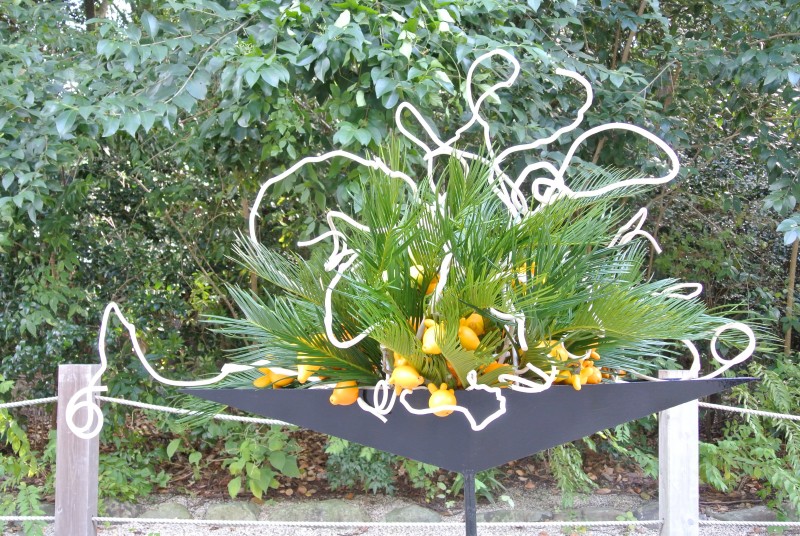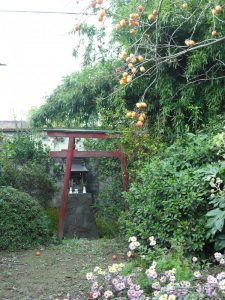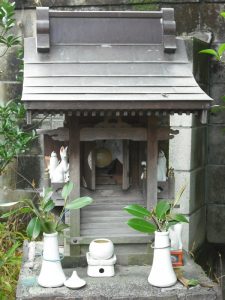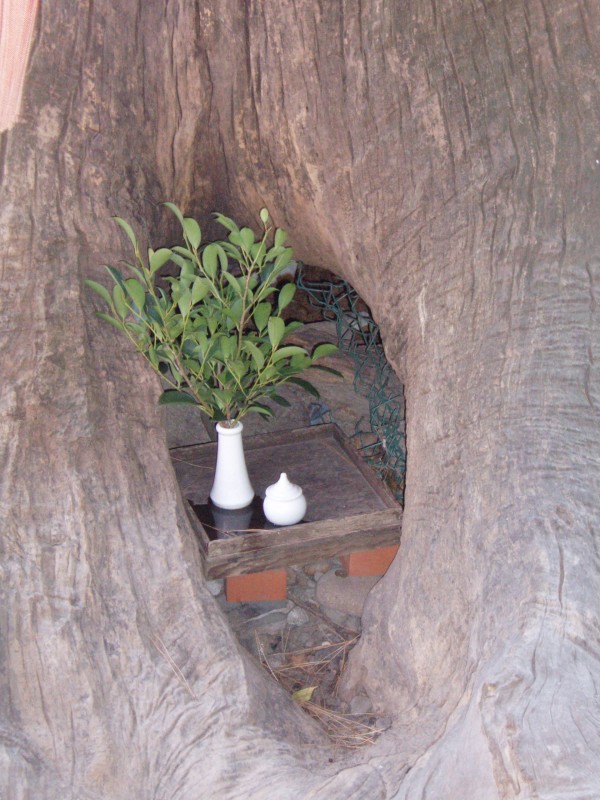
Shinto inspired art in the grounds of Shimogamo Jinja
What would a Shinto garden look like? One might presume there would be a sacred tree, possibly striking in some way such as being ancient, or having an unusual form, or for being a fine example of the life-force. One would expect too on entry a water basin or fountain for purifying hands and heart. Perhaps there would be a place to hang ema (wooden votive plaques), and even some means of having one’s fortune told. Above all, one would expect a small shrine honouring the tutelary guardian, where one could pray in ritual fashion to the spirit of place.
In the piece below Green Shinto reader, Sally Writes, has come up with some ideas of her own about how to create the right atmosphere for a garden of devotion. (Photos by John Dougill)
***************

Garden shrine and torii
Creating A Shinto Inspired Garden (by Sally Writes)
According to ancient Eastern principles Shinto-inspired Zen gardens represent nature in miniature format, and creating your own outdoor retreat can bring peace and happiness to your life. This is linked to the healing benefits of nature; scientists have found that being around trees reduces stress levels in the human body, helping us to relax.
Here are a few tips to help you create a Shinto inspired garden.
Add A Water Feature
Many people like to add a water feature to the garden to create a serene Zen effect. Water has a positive energy that is well suited to a Zen garden, and water is linked to the most pertinent purifying ritual of the Shinto faith. Studies have also found that the sound of water has a relaxing effect on humans, which is ideal for a Shinto inspired garden.
Include Other Shinto Inspired Features
You can also add stone or Shinto-inspired art to your garden, or you could add piles of rocks to create a Zen-like boulder pile. Stone lamps can also be used to illuminate the beautiful features in your garden – and it will also make it easier for you to appreciate your garden at night time.

Inari hokora, perfect for garden usage
Add Plants And Paths
The most important part of any Shino-inspired garden are the plants and pathways. It is important to add bright flowers for yang energy and dark green plants for yin energy, such as bonsai tree, as this will ensure that your garden has positive energy, rather than negative energy. You can also create a winding path that goes through the garden to imitate ancient Japanese gardens – just make sure that you know how to dig out a path before you start.
Once you have created a path you can also add stones and boulders to the edges to give you garden even more of a vibe.
It is easy to turn your garden into a Shinto-inspired garden without spending too much. This will make your garden more peaceful and relaxing, but that isn’t all; the beauty of the garden will also help you to connect with nature and ancient Japanese culture.

Not every sacred tree needs a shimenawa rice rope to sanctify it. Even the simplest of arrangements will do.

This is such a beautiful post and really fuels my desire to make a garden shrine happen! Thank you for sharing!
Is it possible to create a list of public garden shrines in America? I live in so cal and the closest shrine is Shusse Inari Shrine in la. It is only public one day a year, so I’m looking for a nearby shrine to visit
A google search suggests that a listing would be rather short, I’m afraid, Eli…. three or four in the entire country it seems.
): if anyone lives in Santa Barbara california and reads this, there is a tiny shrine at lotus land garden. Possibly an Inari shrine.
Thank you for mentioning that, Eli. I see that Lotusland in Santa Barbara contains several kinds of gardens, one of which is a Japanese garden with a small Shinto shrine surrounded by Sugi (cryptomeria) and other kinds of trees. The question would then be whether the shrine has ever been consecrated or is simply a decoration. Since there is no mention of annual ceremonies or festival, it would presumably be the latter.